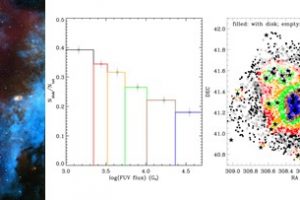Young stars in massive star-forming regions. The results of the “Chandra Cygnus OB2 Legacy Survey” recently published

Today in the Milky Way, star formation typically occurs in low-mass environments. Young star clusters (e.g., younger than 10 million years), in fact, typically have a mass of a few hundred solar masses. Nevertheless, our Galaxy hosts a few very massive star-forming regions that can produce tens to hundreds of thousands of stars, including some of the most massive stars known.
In such high-mass star-forming regions, both star formation and early stellar evolution occur differently than in low-mass star-forming regions. This is primarily due to the presence of numerous massive stars formed in these regions, which generate a local field of energetic radiation (UV and X-rays) that is millions of times more intense than in low-mass star-forming regions. This radiation influences the gravitational collapse and fragmentation of molecular clouds, affecting the products of star formation, as well as the dispersal and evolution of protoplanetary disks around young, low-mass stars, thereby impacting the process of planet formation.
Massive star-forming regions are relatively rare in the vicinity of the Sun. The nearest one to us is the young and massive OB association Cygnus OB2, which is an extensive star-forming region within the Cygnus-X complex. It spans several tens of light-years in width and is located approximately 4500 light-years away from us. Over the past 5 million years, this region has given birth to thousands of stars within a low-density stellar association. Among these stars, there are some of the most massive stars known in the Milky Way, such as CygOB2-7, an O3 star with a present-day mass of about 50 solar masses, and four Wolf-Rayet stars with masses ranging from 10 to 50 solar masses and extremely high effective temperatures. Due to these characteristics, Cygnus OB2 is one of the best regions for studying star and planet formation in high-mass star-forming regions.
This initiative has motivated the “Chandra Cygnus OB2 Legacy Survey,” a multi-band observing program of Cygnus OB2 led by the astronomer J. J. Drake from the Harvard-Smithsonian Center for Astrophysics. The program is primarily centered on extended observations in X-rays using the NASA satellite Chandra, lasting approximately 305 hours. These data are critically important for identifying the young stars within the association and for studying their high-energy phenomena. They have been complemented by available optical and infrared data, along with specific observations conducted with the Gran Telescopio Canaria. This comprehensive approach has enabled the acquisition of a complete understanding of star formation and early stellar evolution within Cygnus OB2.
The results of the survey have been recently published in a special issue of the “Astrophysical Journal Supplements”, and it contains the following papers:
- “The Chandra Cygnus OB2 Legacy Survey: Design and X-Ray Point-source Catalog” of N. J. Wright (Keele University), which describes the analysis of the X-ray data and the compilation of the catalog of 7924 X-ray sources in this region;
- “Simulating the Sensitivity to Stellar Point Sources of Chandra X-Ray Observations” of N. J. Wright (Keele University), presenting simulations of the sensitivity reached by the X-ray observations, which is the minimum sources X-ray flux observable as a function of the position in the field;
- “Optical and Infrared Counterparts of the X-Ray Sources Detected in the Chandra Cygnus OB2 Legacy Survey” of M. G. Guarcello (INAF – Osservatorio Astronomico di Palermo), which describes the complex procedure adopted in order to find the optical and infrared counterparts of the X-ray sources in the catalog;
- “Classification of Chandra X-Ray Sources in Cygnus OB2” of V. Kashyap (Harvard-Smithsonian Center for Astrophysics), presenting the source classification method of the X-ray sources, based on a principal-component analysis, and the identification of about 6100 sources associated with Cygnus OB2;
- “The Statistical Uncertainties on X-Ray Flux and Spectral Parameters from Chandra ACIS-I Observations of Faint Sources: Application to the Cygnus OB2 Association” of J. F. Albacete-Colombo (Universidad de Rio Negro), which presents a statistical analysis of the uncertainties associated with the estimate of X-ray fluxes from Chandra observations;
- “X-Ray Spectral Characterization of the Young Cygnus OB2 Population” of E. Flaccomio (INAF – Osservatorio Astronomico di Palermo), which presents the analysis of the coronal properties of the X-ray sources, in particular of the stars associated with Cygnus OB2;
- “Photoevaporation and Close Encounters: How the Environment around Cygnus OB2 Affects the Evolution of Protoplanetary Disks” of M. G. Guarcello (INAF – Osservatorio Astronomico di Palermo), which demonstrates that the dispersal of protoplanetary disks is faster nearby to massive stars because of the intense UV radiation incident on the disks. This set important constrains to our knowledge of planets formation in very massive environments.
- “Diffuse X-Ray Emission in the Cygnus OB2 Association” of J. F. Albacete-Colombo (Universidad de Rio Negro), which presents a detailed analysis of the diffuse X-ray emission in the region, produced by the intracluster plasma at million degrees.
- Another study which is part of the survey, but not published in the special issue, is “X-Ray Emission from Massive Stars in Cyg OB2” of G. Rauw (Université de Liège), which presents an analysis of the high-energy phenomena in the very massive stars of Cygnus OB2.
The figure (click here to view it in full) displays a multi-band image of Cygnus OB2, with X-ray emissions (from sources and diffuse emission) depicted in blue, optical data from the Isaac Newton Telescope shown in red, and infrared emissions from the Spitzer Space Telescope represented in orange.
Mario Giuseppe Guarcello ( follow mariospiegacose) ( mariospiegacose) ( follow mariospiegacose)
Follow the Astronomical Observatory of Palermo on Facebok and on Instagram
Subscribe the Youtube channel of the Astronomical Observatory of Palermo
